Playlist
Show Playlist
Hide Playlist
IE Management: Other Procedures Requiring Antibiotic Prophylaxis
-
Slides InfectiveEndocarditis InfectiousDiseases.pdf
-
Reference List Infectious Diseases.pdf
-
Download Lecture Overview
00:01 So, when we have to use antibiotic prophylaxis, we should use it. So, when do we recommend that you use antibiotics to prevent endocarditis? Well, anytime we’re going to do have manipulation of the gingivae, like major dental surgery, drainage of an abscess, or the periapical regions of the teeth. 00:29 Any kind of major surgery involving perforation of the oral mucosa, say extensive ENT type surgery in patients who are at risk for endocarditis. These patients would be those who have a prosthetic heart valve. It’d be horrible to get one of those infected. So, we err on the side of over treating them. 00:53 Someone who has had previous infective endocarditis is likewise predisposed to get it again. 01:01 So, we would definitely give them antibiotic prophylaxis as we would patients with congenital heart disease. 01:09 And because of the consequences of missing it, somebody who’s had a heart transplant or who has some kind of valvulopathy, we certainly would err on the side of over-prophylaxing them. 01:23 What we use generally is amoxicillin in oral form, 2g. That’s usually just one dose about 30 minutes prior to the procedure. If they’re unable to take by mouth then we’re forced to give them ampicillin either by vein or intramuscularly but they still need it. If they’re penicillin allergic, we recommend cephalexin, clindamycin for the oral regimen. If they can’t take that, it would be IV cefazolin or ceftriaxone or IV clindamycin. All of this is in a single dose. Other procedures that require antibiotic prophylaxis include major kind of invasive procedures in the respiratory tract, incisional biopsy of the respiratory tract mucosa, taking out the tonsils or adenoids. It’s really the same as for dental procedures. 02:32 Procedures that treat established infection, for example, drainage of an abscess. I should remind you that here, we give more than one dose because we’re treating a disease. We’re treating an abscess. 02:47 So, we would complete the therapy for such a problem because this is treatment, not prophylaxis. 02:55 Other procedures requiring antibiotic prophylaxis would be musculoskeletal surgery, a procedure to treat some established infection in the muscles or cellulitis in the skin, or septic arthritis or osteomyelitis. 03:15 Once again, these are conditions that we would complete treatment on, not a single dose. 03:21 We would base our treatment, not really prophylaxis, our treatment on the basis of the organism causing the problem. The other thing is GI or GU procedures. We used to recommend treating or giving prophylaxis to anybody getting one of these. But actually, those guidelines that I mentioned no longer recommend antibiotics for GI or GU tract procedures with one caveat. That would be that if somebody has a urinary tract infection and they have to undergo some kind of invasive procedure emergently, you would go ahead and treat. But it’s treating an active infection rather than prophylaxis.
About the Lecture
The lecture IE Management: Other Procedures Requiring Antibiotic Prophylaxis by John Fisher, MD is from the course Cardiovascular Infections.
Included Quiz Questions
Which of the following patients is most likely to require antibiotic prophylaxis to avoid infective endocarditis?
- A 2-year-old boy with repair of ventricular septal defect 4 months ago who is undergoing tonsillectomy
- All pregnant women who receive dental cleaning procedures
- A 58-year-old woman who has a prior history of infective endocarditis who is about to undergo a screening sigmoidoscopy
- A 65-year-old with a prosthetic heart valve who needs cystoscopy for evaluation of painless hematuria
- A patient with a prosthetic joint about to undergo dental procedure
What is the typical prophylactic regimen to avoid infective endocarditis in a high risk patient about to undergo dental surgery?
- Amoxicillin: 2g orally for one dose 1 hour prior to procedure
- Amoxicillin: 2g orally daily for 1 week prior to procedure
- Gentamicin: 1 g intravenously during the procedure
- Clindamycin: 800mg orally for 1 week after procedure
- Cephalexin: 2 g orally daily for 3 days prior to procedure
Customer reviews
5,0 of 5 stars
| 5 Stars |
|
5 |
| 4 Stars |
|
0 |
| 3 Stars |
|
0 |
| 2 Stars |
|
0 |
| 1 Star |
|
0 |





